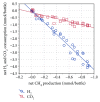Hydrogenotrophic Methanogenesis and Autotrophic Growth of Methanosarcina thermophila
- PMID: 30123085
- PMCID: PMC6079545
- DOI: 10.1155/2018/4712608
Hydrogenotrophic Methanogenesis and Autotrophic Growth of Methanosarcina thermophila
Abstract
Although Methanosarcinales are versatile concerning their methanogenic substrates, the ability of Methanosarcina thermophila to use carbon dioxide (CO2) for catabolic and anabolic metabolism was not proven until now. Here, we show that M. thermophila used CO2 to perform hydrogenotrophic methanogenesis in the presence as well as in the absence of methanol. During incubation with hydrogen, the methanogen utilized the substrates methanol and CO2 consecutively, resulting in a biphasic methane production. Growth exclusively from CO2 occurred slowly but reproducibly with concomitant production of biomass, verified by DNA quantification. Besides verification through multiple transfers into fresh medium, the identity of the culture was confirmed by 16s RNA sequencing, and the incorporation of carbon atoms from 13CO2 into 13CH4 molecules was measured to validate the obtained data. New insights into the physiology of M. thermophila can serve as reference for genomic analyses to link genes with metabolic features in uncultured organisms.
Figures




Similar articles
-
Acetoclastic and hydrogenotrophic methane production and methanogenic populations in an acidic West-Siberian peat bog.Environ Microbiol. 2004 Nov;6(11):1159-73. doi: 10.1111/j.1462-2920.2004.00634.x. Environ Microbiol. 2004. PMID: 15479249
-
Methanogenic community composition and anaerobic carbon turnover in submarine permafrost sediments of the Siberian Laptev Sea.Environ Microbiol. 2009 Mar;11(3):657-68. doi: 10.1111/j.1462-2920.2008.01836.x. Environ Microbiol. 2009. PMID: 19278451
-
Methanosarcina semesiae sp. nov., a dimethylsulfide-utilizing methanogen from mangrove sediment.Int J Syst Evol Microbiol. 2000 Jan;50 Pt 1:171-178. doi: 10.1099/00207713-50-1-171. Int J Syst Evol Microbiol. 2000. PMID: 10826801
-
Several ways one goal-methanogenesis from unconventional substrates.Appl Microbiol Biotechnol. 2020 Aug;104(16):6839-6854. doi: 10.1007/s00253-020-10724-7. Epub 2020 Jun 15. Appl Microbiol Biotechnol. 2020. PMID: 32542472 Free PMC article. Review.
-
Metabolism of methanogens.Antonie Van Leeuwenhoek. 1994;66(1-3):187-208. doi: 10.1007/BF00871639. Antonie Van Leeuwenhoek. 1994. PMID: 7747931 Review.
Cited by
-
Stromatolites as Biosignatures of Atmospheric Oxygenation: Carbonate Biomineralization and UV-C Resilience in a Geitlerinema sp. - Dominated Culture.Front Microbiol. 2020 May 19;11:948. doi: 10.3389/fmicb.2020.00948. eCollection 2020. Front Microbiol. 2020. PMID: 32508777 Free PMC article.
-
Soil-Derived Inocula Enhance Methane Production and Counteract Common Process Failures During Anaerobic Digestion.Front Microbiol. 2020 Oct 20;11:572759. doi: 10.3389/fmicb.2020.572759. eCollection 2020. Front Microbiol. 2020. PMID: 33193175 Free PMC article.
-
Anaerobic digestion of whey permeate: Impact of feedstock ratio and organic loading rate in batch and semi-continuous systems.Heliyon. 2025 Feb 4;11(4):e42395. doi: 10.1016/j.heliyon.2025.e42395. eCollection 2025 Feb 28. Heliyon. 2025. PMID: 40066021 Free PMC article.
-
Medium Preparation for the Cultivation of Microorganisms under Strictly Anaerobic/Anoxic Conditions.J Vis Exp. 2019 Aug 15;(150):10.3791/60155. doi: 10.3791/60155. J Vis Exp. 2019. PMID: 31475968 Free PMC article.
-
Pre-treatment with Trichoderma viride: Towards a better understanding of its consequences for anaerobic digestion.Environ Microbiol Rep. 2024 Aug;16(4):e13281. doi: 10.1111/1758-2229.13281. Environ Microbiol Rep. 2024. PMID: 38940659 Free PMC article.
References
-
- Dridi B., Fardeau M.-L., Ollivier B., Raoult D., Drancourt M. Methanomassiliicoccus luminyensis gen. nov., sp. nov., a methanogenic archaeon isolated from human faeces. International Journal of Systematic and Evolutionary Microbiology. 2012;62(Part 8):1902–1907. doi: 10.1099/ijs.0.033712-0. - DOI - PubMed
-
- Keltjens J. T., Vogels G. D. Conversion of methanol and methylamines to methane and carbon dioxide. In: Ferry J. G., editor. Methanogenesis - Ecology, Physiology, Biochemistry and Genetics. New York: Springer Science & Business Media; 1993. pp. 253–303.
Publication types
MeSH terms
Substances
LinkOut - more resources
Full Text Sources
Other Literature Sources
Molecular Biology Databases

